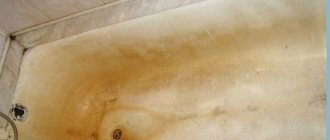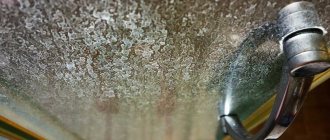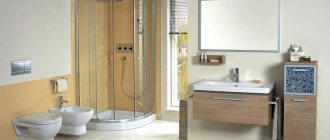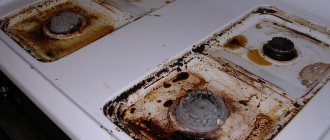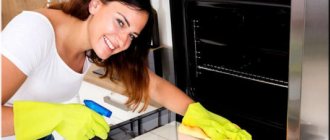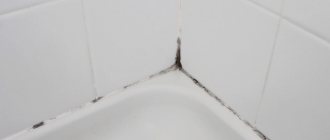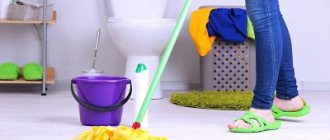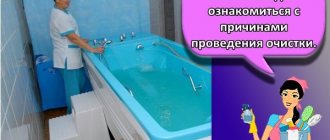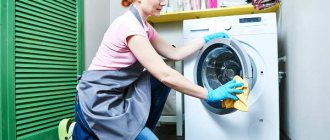Connoisseurs of practicality and convenience are increasingly installing modern compact shower stalls in their bathrooms instead of bulky old-style bathtubs. Agree that any plumbing fixtures need careful care, and a shower stall with transparent walls requires especially careful treatment.
But how to wash a shower stall and what nuances to consider when choosing products for treating plumbing? It is these questions that we will consider in the article. Let's look at the intricacies of daily care and the features of general cleaning.
We will also provide a list of the best purchased products and homemade solutions that can be made from materials available in the kitchen. For clarity, we will provide the article with visual photos and useful video recommendations for caring for shower stalls.
Cleaning individual elements from plaque
Let’s now look at how to eliminate drips, traces of scale, and other contaminants from individual parts of the shower stall.
Tap and mixer
Taps, mixers, shower and hydromass nozzles are made of metal. They can be cleaned with weak acids - acetic, citric. Solutions are conveniently applied from a spray bottle. After 10–15 minutes, the remaining acids are washed off with running water.
Pallet
For the manufacture of pallets, several materials are used that differ in their properties. Usually this:
- ceramics or faience;
- acrylic;
- cast iron;
- enameled steel.
When choosing cleaning methods, you should consider the material from which the tray is made.
Acrylic is easily scratched, so you should be especially careful when choosing a descaling product. Lime forms here quite quickly. To remove minor stains from acrylic trays, soap and a sponge are often used.
When using purchased products, you must make sure that they can be used to clean acrylic surfaces. For old scale marks, you can use toothpaste. It needs to be applied to a sponge, treated the entire surface, and then rinsed off.
In particularly difficult cases, use the following method:
- Fill the tray with warm water and table vinegar in a 1:1 ratio.
- Leave the mixture for 2–3 hours. For severe stains, you can leave it overnight.
- After this, the tray is thoroughly washed.
Using this method, you can remove traces of rust, deposits, and scale. Citric acid gives a good effect. Any abrasive substances, including soda, cleaning powders, should be excluded.
Enameled trays made of cast iron and steel have a thin coating. It may be scratched by abrasive materials. Deposits and dirt must be removed carefully. Acetic and citric acid have proven themselves well for cleaning enamel trays. Among the purchased products, the well-known Pemolux and Komet have a good effect.
Glass
Often the walls and doors of shower stalls are made of glass. To remove traces of scale, you can use special glass cleaning products. They are usually produced in the form of a spray. Use it like this:
- Spray the drug from a spray bottle.
- Leave for 10-15 minutes (the instructions indicate the exact time for each product).
- Clean the glass surface with a damp sponge.
- Wipe dry with a dry soft cloth.
Good results are obtained by cleaning with Mister Muscle, Sanelit, Cif. For old scale stains, a solution of citric or acetic acid helps. They can wash away almost all stains.
- These products are applied to the surface.
- Wipe with a sponge or brush.
- Wash off with water and be sure to wipe the walls dry.
After their application, the glass will return to its original appearance and transparency.
Plastic
Plastic is often used to make booth walls. This is a soft material that can be scratched. Therefore, when cleaning it, you cannot use abrasive substances. Good results are obtained with the use of the drug Antinakipin:
- Prepare a hot solution of Antiscale.
- Apply the resulting mixture to plastic surfaces.
- Leave for 5–10 minutes.
- Wipe off any remaining product with a sponge.
- Wash with water.
In cases of severe contamination, specialized preparations in the form of gels and solutions are used.
Cleaning the tray
When cleaning the shower stall, many housewives wonder how to wash the shower tray? Before you begin eliminating limescale, you need to determine what material this part of the shower stall is made of. The pallet can be made from the following types of materials:
- faience;
- acrylic;
- ceramics;
- cast iron;
- enameled steel.
Acrylic tray
Despite all the capriciousness, acrylic is still a very warm and good material. It is recommended to remove various stains from it by using a clean soft cloth or sponge, which is first recommended to be soaped with laundry soap. Limescale deposits from acrylic can be easily removed using any dishwashing detergent, as well as a toothbrush and toothpaste, which is recommended to be first applied to the problem area, left for a few minutes, and then thoroughly brushed and rinsed with water.
On the shelves of modern industrial stores there is a wide selection of specialized products for cleaning and washing acrylic bathtubs and trays. In most cases, such substances have a creamy structure, which simplifies the method of their use. It is enough to apply this product with a cloth or sponge to the contaminated area, leave for 15–17 minutes, and then simply rinse everything off with water.
In more severe cases, when there is a strong deposit of limescale on the shower tray, you can use silver polish, but first you should study all the information on how to clean a shower stall using this product.
Stone tray
If the pallet is made of natural stone, then maintenance is minimal. It retains all its color characteristics throughout the entire period of its operation, no matter how many years have passed. When limescale deposits form on natural stone, it can be effectively and easily removed using a clean cloth and a steam cleaner. In rare cases, a chemical cleaner may be needed.
If the pan is made of an artificial type of stone, then such a plumbing product may darken over time. And in order to restore the tray to its former brightness, it is recommended to clean it with a concentrated toilet cleaner, after first protecting the surface of your hands with rubber gloves. After cleaning, the tray should be thoroughly rinsed with water.
Enameled tray
An enameled tray is a sanitary product made of enameled steel or cast iron, which is then coated with an enameled paint composition. When caring for and cleaning such a tray, it is not recommended to use chemicals that contain the following components:
- sulfuric acid;
- alkali;
- formaldehyde;
- hydrochloric acid.
The most effective means of combating plaque and dirt on the enamel surfaces of the pallet is the use of Pemolux or Comet.
You can also use a folk remedy for cleaning enamel surfaces, which you can easily prepare at home. To do this, mix soda and citric acid with water to the consistency of a thick paste. After this, it is recommended to apply the resulting mixture to the stained area for 30–35 minutes, after which it is rinsed off with running water.
Caring for tiles and ceramics at home
These home remedies should be used by those housewives whose shower walls are tiled.
Fight plaque with vinegar.
The use of chemical acid often leaves stains. You can wash the tiles in the bathroom and shower with regular vinegar.
How to do this: a six percent solution can be used through a spray bottle. Spray vinegar over the surface, leave for a quarter of an hour, wipe off the solution with a clean rag or cloth (preferably microfiber).
Citric acid against plaque.
Citric acid can be used every day; it is a completely gentle treatment. The fine-crystalline powder is applied with an ordinary damp sponge, the surfaces are cleaned and washed off with water.
How to get rid of mold in the cabin
In practice, mold formation occurs due to the fact that there is poor ventilation in the room, that is, evaporated moisture remains in the room, settling on the surface. Thus, living bacteria have every chance to “settle” in their usual habitat.
To prevent it, you need to thoroughly ventilate the bathroom after taking a shower. Ideal if the room has windows. As a rule, they are left in ventilation mode after bathing. This way, the cabin will dry quickly and the tiles will not become covered with bacteria and mold.
No less popular when cleaning the cabin is citric acid. This is a kind of universal washing powder. To use it as a shower cleaner, you need to dilute 30 g of acid and 20 g of soda in 200 ml of warm water.
Place this solution in a spray bottle and then apply it to the contaminated element. This solution is left for 10 minutes and then washed off with warm water.
If fungus begins to form in the cabin, a non-concentrated chlorine solution will help eliminate it. Be sure to thoroughly ventilate the room after treating the surface of the booth with chlorine.
Experienced housewives know that the best way to remove stubborn dirt from an acrylic tray is toothpaste. It is its use that allows you to permanently clean an acrylic bathtub from yellow stains, remove plaque and dirt, without damaging the fragile surface of the acrylic.
How to do a general cleaning
Daily and scheduled cleanings do not remove all the dirt, dirt gradually accumulates, and plaque grows. General cleaning brings the shower stall to perfect condition. It is carried out in several directions using effective special means.
See also
What is the best way to paint a pine staircase in a house, rules and step-by-step instructions
Removing limescale
Folk and special means dissolve limescale. Of the ready-made preparations, it is better to use gel-like ones; they are better retained on the surface. Active substances (fruit acids) do not cause darkening or lightening of parts. Choose products based on the material of the surface being treated - Comet, WC-Gel, Cillit Bang, vinegar, citric acid.
Cabin glass cleaning
When cleaning glass, the product is sprayed onto the surface and left for 3-6 minutes, then wiped with a dry, lint-free cloth. Use ready-made preparations with a spray bottle or traditional ones - ammonia, vinegar.
How to clean a tray
Acrylic trays are cleaned using special products that do not destroy the structure of the material (Acryl-Net, Akrilan). Apply the drug for a few minutes, then wash off. For stone pallets, a steam cleaner is recommended that does not cause darkening of the material. Metal coated with enamel is cleaned with gel-like preparations such as Comet; they are convenient to apply and quickly dissolve stubborn dirt.
How to get rid of mold
Chlorine solutions are used to remove mold. They are applied for 40-60 minutes, then washed thoroughly. It is important to apply the solution into all cracks, joints, and cover smooth surfaces. If the mold cannot be removed, fungicides are used. It is important to read the instructions to avoid damaging the material.
Among the folk remedies, laundry soap and vinegar fight fungus well. You will have to process more than once.
Important: the shower stall must be thoroughly wiped and ventilated after use, otherwise mold cannot be dealt with.
Tips and tricks
The shower shines with whiteness and cleanliness only when purchased, but during use, the shine is lost. The cabin becomes unsightly, with remnants of soap stains and streams of water. To avoid this, it is necessary to promptly clean the installation from traces of use, using appropriate and suitable means, in particular sprays, aerosols, etc.
All products are very harmful to humans, which means that when using such solutions, it is necessary to observe safety precautions, keep the cabin doors open and preferably the windows in ventilation mode to avoid possible poisoning.
If rust begins to appear in the booth, you can get rid of it with vinegar. It is also applied to the surface using a spray bottle. Leave on for at least 30 minutes and then wash off.
The best way to remove contamination is considered to be special means for washing acrylic bathtubs - if the tray is made of plastic, as well as for washing windows - if it is a glass cabin. It is necessary to apply such products to the walls when cleaning. The products should be left for 10-15 minutes, then rinsed with water. Thus, it is possible to prevent the appearance of plaque on the walls in advance, and therefore carry out plaque prevention.
If it is necessary to restore the shower cabin, use appropriate specialized restoration products
At the same time, it is important to distinguish that for a specific material there is its own line of products.
You cannot use powders, even if they are universal.
In order to prevent contamination, you need to use a suitable tool. In particular, scrapers and brushes, as they perfectly remove plaque without detergents
It is better to use the scraper constantly.
Caring for a shower cabin is the key to its long-term use, therefore it is necessary to constantly wipe the surface of the walls and doors of the cabin from dried drops, as they become the basis for plaque. All this is due to the content of salts and minerals in the water. If you do not do this in a timely manner, over time, yellowness and mold will appear on the surface.
If we talk about the tray, then under no circumstances should you clean the acrylic tray with products containing abrasive particles. When using detergent, it is necessary to distribute the substance evenly; when using a synthetic sponge, the detergent. Then you need to leave it for 10 minutes, rinsing off with warm water.
The best option for cleaning an acrylic tray is to use a soft sponge. It can be replaced with a cloth napkin. To ensure that the tray always pleases with its shine, it is rubbed with a special wax-based polish.
It is strictly forbidden to use acetone or ammonia as a cleaning agent, as well as various formaldehydes and formic acid.
Design and care features
The main difficulty in caring for the booth is that in a limited enclosed space with an aggressive environment, parts from different materials are collected, requiring special means and approaches for cleaning.
Pallet
Pallets are made from several types of materials, the most common being acrylic and steel. Artificial or natural stone is used in expensive models of shower cabins. All these materials do not tolerate abrasive agents. All deposits and old drops of dirt are not cleaned off, but dissolved, so as not to scratch the coating.
Fencing
The material for the walls is tempered glass or more affordable plastic. It is difficult to damage glass, but plastic is easy to scratch when using abrasive powders. Sometimes the role of one or two walls of the cabin is performed by tiled wall coverings.
Watering can, taps, holders
Water supply elements are made of different types of metal (chromed steel, stainless steel), often in combination with plastic. For gentle washing, special gel-like compositions are used.
Hydromassage jets
End and rotary nozzles are made of plastic or metal. These are one of the most important structural elements that require high-quality cleaning for complete water dispersion.
The cabin walls are supported by a frame made of aluminum profile coated with paint.
Everything shower cabin owners need to know
The appearance of plaque is associated with the quality of water - sometimes it is impossible to fight this. Pollution from hard water accumulates, staining the walls, cabin tray, and glass. They need to be removed with a soft scraper, but in some places they are difficult to work with.
- After each water procedure, it is required to leave the cabin doors open for ventilation. This will help prevent mold from forming.
- Special products are used to remove plaque and traces of water hardness on glass. They can be purchased at hardware stores. Before use, you need to study the instructions and composition. Contaminants are removed using protective gloves in a ventilated area.
- The fight against mold is carried out with chemical compounds containing chlorine or hydrogen peroxide. The products are sprayed onto the required surface, left for the recommended time, washed off with water, and wiped dry with a rag.
- Cleaning of trays and booth walls is carried out using detergents (acids and other substances) in accordance with the materials used to make the surface being cleaned. An incorrectly selected product can damage the pan and cabin walls.
- The choice of an aggressive chemical composition must be made taking into account individual intolerance to the components and the possibility of allergic reactions. For allergy sufferers, it is better to use alternative folk methods of cleaning the surface of the cabin, glass, shower, bathtub, trays, and tiles.
Adviсe
To ensure that your shower stall is always clean and lasts for many years, you need to follow a few simple recommendations from experts.
Acrylic cleaning products are ideal for cleaning plastic shower cabins. To clean the glass doors and walls of the product, you can purchase window cleaner. It must be applied to the surface of the cabin, and then washed off with water after 15 minutes. This procedure will prevent the formation of soap scum.
Experts do not recommend using powder products to clean the shower stall, as they can damage the surface of the product. To prevent the formation of dirt, you can use a brush or scraper. Scrapers called rails are an excellent way to remove plaque from the surface of the shower stall. They fit tightly to the surface and are soft. The cabin should be cleaned every time after taking a shower.
If you need to eliminate contamination, you can use folk remedies. The best choice is a solution that consists of water, citric acid and soda. It should be poured into a spray bottle and then sprayed on the walls of the booth. To prepare a cleaning solution for 200 ml of warm water, you will need 20 grams of citric acid and 20 grams of soda. The product is applied for only 10 minutes, after which it must be thoroughly rinsed off the walls with water. It will add shine to the shower stall.
If the shower stall has an acrylic coating, then it is necessary to use only products designed specifically for cleaning acrylic bathtubs. Other cleaning agents may damage the acrylic coating.
It is very difficult to get rid of mold, so it is better to practice prevention and not allow it to form. The cabin requires regular ventilation; the sealant must be regularly treated with special sprays. If mold does appear, it is better to replace the old sealant with a new one.
It is better to avoid using chemical solvents as they can damage the finish of the shower stall. They negatively affect the condition of acrylic pallets and plastic walls.
It is better to always keep the cabin doors slightly open. This will allow moisture to evaporate faster and will be an excellent prevention of mold formation. Vinegar helps a lot in fighting rust. It is better to take a spray bottle to use it. After spraying, rinse it off with water after half an hour.
To learn how to clean a shower stall without a brush or effort, watch the following video.
How to deal with stains on walls
Even after thorough cleaning, untidy streaks may remain in the shower stall, casting a shadow on the owner’s reputation. The old habit of wiping all polished surfaces with a cloth lets us down, but textiles are not suitable for plastic, glass and ceramic tiles. In addition, a rough cloth, a brush or a brush with stiff bristles can scratch the tray or the walls of the hydrobox and damage the anti-corrosion coating of the steel reinforcement. To keep your shower cabin looking attractive for as long as possible, use non-marking materials and tools to clean the box and remove residual moisture:
- melamine sponge;
- pieces of non-woven latex or microfiber fabric;
- steam cleaners;
- rails and scrapers made of polyurethane, rubber and silicone.
Folk remedies
If for some reason you do not want to use cleaning products from modern manufacturers of household chemicals, then the following recommendations will help you in cleaning the shower stall at home:
You can independently prepare a fairly effective spray for cleaning the surfaces of the shower stall. Make a solution from water, to which you should add citric acid and soda in a ratio of 1.5:1, then mix the resulting composition thoroughly. After adding it to a spray bottle, spray the product onto the surface of the walls and leave for 10-15 minutes. Then all you need to do is rinse the surface with running water.
- The chrome-plated surfaces of the structure can be cleaned of limescale deposits by wiping them with the favorite drink “Coca-Cola”.
- Areas of heavy contamination can be cleaned with toothpaste, which is squeezed out of the tube onto the stains and simply washed off after 15-20 minutes.
Hi all!
If you wash yourself, wash your bath too! Alas, we do not always follow this wisdom, although we should. Over time, washing bathtubs and shower stalls becomes a real problem: unpleasant residue from water and residues of soap, gels and shampoos accumulate on the walls.
And if cleaning the bathtub is a relatively minor problem, then the shower stall, due to its very design and dimensions, brings a lot of trouble to housewives.
But with the help of my tips collected below, you can easily cope with the most stubborn stains and will no longer be tormented by the question of how to clean the shower stall from plaque.
How to wash plumbing and metal elements
These guys are also prone to dark spots and mildew. But their main enemies are rust and limescale.
Harsh cleaners are not suitable for cleaning chrome and nickel plated surfaces. They will leave scratches. Choose a liquid product specifically designed for such elements. As a folk recipe, a solution of wine vinegar and table salt is offered.
The recipe is simple:
- Add two tablespoons of salt to 100 ml of wine vinegar;
- Place the solution in the microwave and heat to 65℃;
- Wipe rust stains with this mixture and leave for 15 minutes;
- Rinse the treated areas with clean water and wipe the surface dry.
Advice: if plaque and rust appear regularly, install water filters or completely replace old water pipes with new ones. This will significantly reduce rusting of plumbing fixtures.
Shower cabin cleaning products
Folk recipes made from ingredients that are almost always available in the kitchen or store-bought cleaning products make it easy to clean the shower stall. It is advisable to do this regularly, as this is the best place for the spread of mold and mildew, which are dangerous to people.
Professional products
Professional formulations are produced in different forms - in the form of pastes, gels, sprays. There are immediately ready-to-use formulations, and there are concentrates from which you need to first prepare a working solution. The following drugs are often used:
- Cif - a cleaning composition in the form of a thick cream from, often found with fragrance and whitening components;
- Tilex is a product from an American manufacturer that has antibacterial properties;
- Akrilan is a domestic product that effectively removes rust, scale and traces of dirt;
- Sanelit is a domestic product that is distinguished by its effectiveness and pungent odor;
- Mister Muscle - Cleans glass surfaces especially well.
Be sure to check the composition of the drugs. Solvents, strong acids, alkalis, and abrasive materials can damage the coating of parts of the booth and ruin its appearance.
Folk
Traditional methods are still quite popular. These methods have been tested in practice. In addition, purchased drugs are expensive.
- Lemon acid. Citric acid should first be dissolved in water. Then thoroughly treat all contaminated surfaces with the resulting solution using a soft cloth. After a few minutes, everything needs to be rinsed off well. The acid dissolves deposited hardness salts without affecting plastic, glass and earthenware parts. Use a solution at the rate of 100 grams of acid per 500 ml of water.
- Vinegar. Vinegar is often used together with a small amount of laundry soap diluted in it. Apply this mixture to contaminated surfaces and wait for some time. Then the remaining solution is washed off generously. Acetic acid removes scale, traces of rust, and other contaminants. The disadvantage is the pungent odor of this substance.
- Baking soda. Apply soda to a damp surface, then wipe off the dirt with a soft cloth and rinse everything with water. The product has abrasive properties, so it cannot always be used. It may leave scratches on plastic parts.
- Steam generator. This product, in addition to removing hardness salts, effectively disinfects surfaces, kills fungus, microorganisms, and their spores. Steam penetrates almost everything, even the most inaccessible places. But steam has a high temperature, so it can deform the plastic parts of the product. In addition, the steam generator itself is an expensive device.
- Toothpaste. Toothpaste effectively cleans metal and acrylic surfaces. Apply a thin layer of paste, which is then rinsed off generously with running water.
Cleaning the tray
Clean the enamel or acrylic tray in the booth with regular toothpaste. It must be applied to the surface in a thin layer. After some time, remove traces of paste with a damp foam sponge and wash the tray with water.
It's even better to use toothpowder for cleaning. It copes with almost all contaminants. You need to sprinkle it on dirty places and rub it a little with a damp cloth. The work ends by washing off the remaining powder with clean water.
Acrylic products are washed with Acrylik Cleaner cream or spray. With its help, all dirty and soap stains are removed. The product does not contain abrasives and does not leave scratches on the surface. The enamel tray is cheap and sleek. It is easy to clean with gels, powders and sprays. Cif and Comet are very popular.
The porcelain stoneware tray has a mirror surface that does not require special care. The material does not accumulate dirt, so it is enough to wipe it. Among the products used to clean such products, one can highlight Mellerud. It copes well with soap scum, limescale, and grease.
Homemade method for removing hard water and soap deposits from acrylic surfaces
Surfaces made of these materials cannot be cleaned with aggressive agents.
Acid (citric).
Dilute 2 packets of the product in 1 liter of water, stir until the crystals dissolve. Using a large sponge, the solution is applied to all surfaces, convex areas and recesses. Holding time is 20 minutes.
The solution is then required to go through again, paying more attention to the most difficult areas with dirt. After the procedure, rinse well with water. The appearance of an acrylic tray or bathtub will again delight you with its novelty.
Acid (oxalic).
Every housewife knows what actions this product has. Prepared compositions with oxalic acid are used for cleaning carpets, upholstery, removing stains from fabrics and much more. This ingredient works great on stains in the bathroom where it can be used. The prepared solution does not have an aggressive effect. Preparation: store-bought product is diluted 5:1 with water. Having moistened a sponge or rag, you need to rub the necessary places, the exposure time is 20 minutes; for light stains, a ten-minute exposure is enough. Then you should rub the plumbing fixtures well, then moisten the cloth in ammonia and repeat the steps, leaving to stand for 10 minutes. Rinse with water (cold pressure and then warm).
Peroxide (hydrogen peroxide).
Hydrogen peroxide has a higher concentration than ordinary peroxide. Combine water (30 ml), hydrogen peroxide (90 ml), gelatin (60 g). Exposure time is a quarter of an hour (until it swells).
A generous amount of the prepared mass is applied to the required areas, left overnight, wipe thoroughly with a sponge in the morning, rinse with water, and wipe dry. If necessary, the steps can be repeated.
Chlorine solution.
Whiteness has long been used for processing pallets and panels made of any materials. Treatment with this solution is popular. Chlorine easily copes with mold, limescale, rust stains and drips. Rub white on all objects, including glass, wait 4 hours, rinse with pressure, wipe dry, apply glass compound (remove whitish stains on doors and glass walls). To use this product, you need to wear protective gloves and a gauze bandage.
Using Melamine Sponge
This modern product is designed to remove salt stains, rust stains, dirt or scale, which is due to the presence of small crystalline elements in the structure of the melamine sponge. Using this product eliminates the need to use many additional cleaning products.
Copes with persistent stains, but some housekeepers complain about its low safety for human health
Compact in size, easy to use and multifunctional, shower cabins require careful care. This way it is possible to extend their service life, as well as maintain the original aesthetics.
Cleaning products
Taking into account the characteristics of the cabin surface, you will need to choose one or another household chemical product
It is very important that it matches your coating and surface. There is no need to use chemicals containing aggressive substances
Avoid using products containing
There is no need to use chemicals containing aggressive substances. Avoid using products containing
- acetone;
- formic acid;
- gasoline;
- formaldehyde.
And no matter what material your shower cabin is made of, you should never wash it with abrasives. Such products can quickly ruin the appearance of your plumbing fixtures, because... they easily scratch any surfaces, which leads to their damage
Daily care
Soap and limescale deposits are quite difficult to remove, but their occurrence can be prevented. To do this, regularly (daily or once every few days) you should perform simple steps:
- After taking a shower, wash the walls with hot and then cold water.
- Rinse off any foam and soap marks thoroughly, paying special attention to corners and hard-to-reach places, where dirt and deposits will be much more difficult to remove. For these purposes, it is best to use a shower with a hose.
- Wipe the walls and other elements of the shower stall dry. Do not leave splashes of water as they may leave salt deposits.
Simple manipulations that take no more than 15 minutes will significantly simplify the maintenance of the structure in the future and help maintain its attractive appearance.
How to wash
To eliminate various types of contaminants on the surface of the shower stall at home, you must follow the recommendations of specialists and follow the following algorithm of actions:
- Cleaning sanitary ware can begin with doors and walls. They can be made of glass or plastic. The latter option requires more frequent cleaning, since the plastic walls and doors very quickly become covered with plaque and become dark.
- If the bathroom stall is located near the wall, then you need to move on to cleaning the ceramic tiles. Ceramics are durable, so they can be cleaned using a variety of alkalis and abrasives.
After this, you can move on to washing metal parts (shower, taps). You need to be very careful with these elements, because if they come into contact with strong products, they can lose their shine. At the very end of washing the cabin, you can proceed to cleaning the tray. When choosing cleaning products, you need to start from what material it is made of.
Attention must be paid to the joints, since this is where mold usually forms.
Lime
An excellent solution in the fight against limescale is the use of a steam generator. It not only allows you to get rid of various contaminants, but also disinfects the surface. But this method is not suitable for plastic surfaces, since this material deteriorates when exposed to hot steam.
Soap scum
The most common contamination of the surface of a shower stall is stains from soapy water. To clean the booth, follow these instructions:
- Regular cleaning. To prevent large contaminations, it is necessary to wash the cabin after each use. You can get rid of soap scum by using regular dishwashing detergent. It is better to use hot water to rinse the walls and tray of the product. The cabin should always be dry, so after cleaning it should be wiped dry.
- Scheduled cleaning. Twice a month you should clean the shower cubicle using special products, the choice of which should be made depending on the material of the product. The product must be applied evenly over the entire internal surface of the cabin using a sponge. After 15 minutes, it should be washed off with hot or warm water, then repeat the procedure, but only using cold water, and also wipe dry.
Mold
Mold is very dangerous to health, so when it first appears, you should immediately take active action to eliminate it.
The main secrets to quickly and easily eliminate mold:
- If you use store-bought products, you should purchase only fungicides. They have a strong effect, so you should carefully read the instructions before using them.
- A popular method for eliminating mold is to use a special solution consisting of ammonia and vinegar in a 1:1 ratio. It should be applied to contaminated areas with a brush. The cleanser should be washed off with soda solution. To prepare it, you will need one teaspoon of soda for one tablespoon of water.
Selection of necessary tools
When caring for a shower stall, you need to take into account the fact that it is made of dissimilar materials. Therefore, we will need certain tools to work. But before picking up the tools, let’s see what our booth is made of:
- plastic and glass are usually used for the manufacture of walls, doors and roofs;
- pallets are usually made of acrylic, but ceramics, natural or artificial stone, and enameled steel are also used;
- frame elements and guides are made of aluminum;
- faucet, handles, shower heads – chrome-plated steel.
To clean the cabin, you will need a soft sponge, a thin rag made of cotton, viscose or microfiber, and a rubber glass scraper.
Soft cloth and microfiber
To properly clean the shower box, first of all, you need to arm yourself with a rag. This is a universal washing tool, but it also has certain technical requirements:
- The material must be strong and durable;
- It absorbs water and dirt well and does not leave behind streaks.
- It is easy to wring out, does not leave lint and provides gentle care for the surface.
The new generation material – microfiber – fully meets these requirements. This is a fabric made of polymers, the thickness of the fibers is several micrometers. The structure of the material resembles a sponge. Absorbs four times its own volume of water, and after squeezing it remains almost dry.
Microfiber is an unnatural fabric material made from the finest polymer fibers.
Rubber scraper
Glass surfaces can be cleaned quickly and effectively using a scraper brush. Structurally, the scraper resembles a mop with a double-sided working surface. The upper part of the tool is equipped with a foam nozzle, and the bottom is equipped with a soft rubber scraper. Using a foam insert, a cleaning solution is applied to the glass. After washing, dirty water is carefully removed with a rubber scraper.
A glass scraper is an ideal option for those who want to save time and effort. It is easy to use, even pleasant.
Foam sponge
Foam rubber is the most common material for sponges. Its porous structure promotes abundant foaming. The difference between sponges is their size and material density. The defining characteristic is density; the higher it is, the more foam is formed during washing, therefore, detergent is saved. The double-sided sponge is equipped with an abrasive layer, which is used to treat surfaces with old dirt.
A foam sponge is one of the best helpers in the fight against a wide variety of stains; paired with a good detergent, it can work real miracles.
Toothbrush
Shower stalls are known to have high humidity. If a bathroom does not have an efficient ventilation system, then mold stains will form in an enclosed space like a stall. It is a harmful substance in the form of a black coating in the corners, in the seams, at the joints. Such places, without delaying for long, must be treated with an antibacterial agent. Since mold most often appears in hard-to-reach places, in order to remove it efficiently, you should use a toothbrush.
Don't throw away your old toothbrush; it may come in handy for cleaning.
Plumbing
When cleaning the shower stall, it is necessary to pay due attention to the care of the plumbing fixtures. Chromed steel parts require careful cleaning to avoid scratches.
Remember that painted aluminum should not be cleaned with aggressive products as this may cause the paint to wear off.
If the faucet is covered with a large layer of salt deposits that does not even open, then you should take a rag, after soaking it in vinegar, and completely wrap the faucet, covering it with cling film to prevent the evaporation of the vinegar. The tap should be left for three hours, and then cleaned of softened deposits. Vinegar can also be used to remove waterscale from nickel and chrome plated parts, rubber gaskets, hoses, drains and faucets.
If the shower head is clogged, this may be due to the formation of limescale. A good choice would be CilitBang. You can also use heated vinegar. The solution should be applied to a spray bottle and after 20 minutes simply rinsed off with water. Afterwards you need to unscrew the watering can and clean all the holes using a toothpick or a sewing needle.
The joys and sorrows of the owner
Compact and functional shower cabins appeared in the apartments of our compatriots relatively recently, but quickly gained popularity due to their practicality, convenience and space saving. It’s hard to argue with the fact that they look more modern and technologically advanced than bulky cast-iron bathtubs, primitive plumbing “mastodons” from the century before last. However, caring for a shower cabin turns out to be more labor-intensive and multi-stage than the usual treatment of a bathtub, faucet and shower with cleaning powder, which takes an experienced housewife no more than ten minutes.
We recommend that you read
How can you clean a shower stall in the same short time, when it consists of many completely different elements, each of which requires an individual approach to hygienic manipulations? Shower head, taps, walls and doors inside and out, tray, shelves, hooks and holders, mirrors and glass, distant hard-to-reach corners - this entire arsenal, made from completely different materials, requires carefully thought-out cleaning tactics and strategies, tools , special detergents and a certain skill.
Review of detergents recommended by housewives
Sanelit.
There are many reviews on forums with photos and videos before and after about how plaque is removed after treatment with Sanelit. Contaminants dissolve before your eyes; difficult stains need to be lightly rubbed with a sponge. The product can be used often; the only drawback is the strong aroma. The composition can be used for cleaning acrylic bathtubs and tray surfaces.
ARON.
Intended for cleaning deposits on cabin windows. Has a foam trigger (for convenient spraying). The work of the household cleaning composition is very simple. It is necessary to spray the glass surface of the booth outside and inside. After a quarter of an hour, the inside is washed off with water, the outside is wiped with a rag. Stains and stains disappear, and not a trace remains of plaque. The product has a ridiculous, cheap price.
Toilet duck.
This is an aggressive composition intended for toilets, but for those with increased water hardness, with remaining traces of a terrible plaque, you can use it for cleaning:
- glass;
- pallets;
- walls in the shower;
- remove difficult stains on bathroom tiles.
The product is made on the basis of acid, so it is better not to use it for nickel-plated products. How should you clean your shower walls and shower tray?
First you need to moisten the shower walls with water. Use a sponge to apply the product to the cab panels, glass and tray. Acid holding time is a quarter of an hour. Then use the same sponge to rinse off the composition with water (strong pressure from the shower).
The surfaces are wiped dry and treated with glass cleaner, rubbed with a dry cloth. The shower looks like it came from a store. This type of care can be done once every two weeks (if necessary), the rest of the time it is better to use more gentle shower compositions.
Mold control
Cleaning a plastic or glass shower stall is not difficult, but dealing with fungus is much more difficult. If you notice black spots in the corners, in seams and hard-to-reach places, immediately use special antifungal compounds. Use them according to the instructions. An alternative could be a mixture of baking soda, ammonia and vinegar.
Mix half a glass of vinegar and ammonia solution, add 0.25 cup of soda. Clean problem areas with the prepared mixture. They can be lightly rubbed with a toothbrush. Leave it on for a while and then wash it off.
Fighting mold in the bathroom - video:
Clean your shower stall in a timely manner, wash away soap stains and wipe the walls dry, then it will be much easier to keep it clean.
Using Cleaning Products
When cleaning your shower stall, choose only a soft fiber cloth. A metal sponge, hard cloth or brush can leave scratches.
What cleaning products can be used to clean a shower stall, and which ones should not be used?
Chemical detergents vary in form and consistency. There are different types: creams and pastes, gels, foams, sprays and liquids.
The most popular of them are spray products, which are simply applied to the surface, rinsed with water and wiped dry. There is no need to rub anything. Very convenient for washing glass.
In order not to spoil the appearance of the shower cabin, when washing, you should not use cleaning products that contain formaldehyde, alkalis, formic or other types of acids, abrasives, organic solvents, or cleaning products with coloring pigments.
Detergents containing abrasive substances leave scratches on the surface and thereby spoil the appearance of the cabin. These include, first of all, various powders. You should not purchase “universal” powders for cleaning the cabin, since they still contain abrasive substances, although the manufacturer may not indicate this.
https://youtube.com/watch?v=UU1EyfwpkFM
It is also not recommended to use metal brushes and hard microfiber sponges, which also leave scratches.
You can wash the shower cabin using a soft rubber or polyurethane scraper, a synthetic sponge, or a soft non-woven fiber cloth. You can also use a special steam cleaner.
spring-cleaning
Unfortunately, not all household members acquire the useful habit of wiping the shower stall every time after washing. Many people forget, others get tired of it.
As a result, surfaces in contact with water become cloudy, yellowish and stale. Therefore, someone will have to do general cleaning of the shower stall as it gets dirty.
In order not to make things worse, let’s note right away what you shouldn’t do to wash a shower stall:
- abrasive cleaning agents, that is, Pemolux type powders;
- chlorine-containing compounds, like “Whiteness”;
- “Domestos”, “Toilet duck” and other products for cleaning ceramic plumbing;
- rub with hard sponges, washcloths, brushes.
The materials used for making shower cabins - sanitary acrylic, tempered glass, plastic - cannot be called delicate, but they can be scratched or damaged by aggressive chemicals and materials.
Shower cabin care
Comprehensive shower cabin care includes several types of cleaning
Daily care. As a measure of daily care, it is recommended that after each use: rinse all internal surfaces and plumbing elements with water, wipe everything dry with a rag or sponge, and ventilate the cabin. These procedures do not take much time, but can significantly reduce the formation of limescale.
Periodic cleaning. It is recommended to wash the booth more thoroughly on average once a week. After treating the surfaces with care products, the insides of the cabin are thoroughly washed, then wiped with a soft cloth so that no drops of moisture remain. This is the main type of care
By paying due attention to it, you can avoid the formation of rust and limescale deposits on the internal parts of the shower stall.
Intensive cleaning. If the cabin has not been used for a long time or it is necessary to remove old, deeply ingrained traces of scale, resort to complete thorough cleaning using potent preparations
You need to wash away scale, dirt, and rust thoroughly and methodically. The products are applied to contaminated areas, and after a while they are thoroughly washed off. After this, all surfaces are wiped and the cabin is ventilated, since such compositions contain active chemical compounds that can be harmful to health.
Using the described recommendations in practice, you can achieve a significant increase in the service life of the shower cabin. A competent choice of cleaning products and regular maintenance can preserve all the performance characteristics of the product and preserve its attractive appearance for a long time.
comments powered by HyperComments
Souvenirs
Wooden Pinocchio
Pinocchio is a symbol of Italy, sold in every souvenir stall. It costs a penny (up to 4.5 €, depending on the size), and is very cute. Suitable as a souvenir for friends, acquaintances or colleagues if the budget does not allow more.
Pinocchio is the Italian brother of our Pinocchio.
venecian mask
The Venetian mask is the perfect souvenir for role-playing game lovers (okay, you can just hang it on the wall). Mass-produced plastic masks are quite cheap (under 10 €). There are ceramic ones that are more expensive (from 30 €), and there are also luxury ones that Venetian masters will paint especially for you (prices for such masks start from 100 €). Choose who you are - the devil, the plague doctor or the crazy empress. Well, if you can, check out the carnival; in 2022 it will be held from February 16 to March 5.
The list can be continued endlessly, but we talked about the most important things. What’s nice is that in Italy there are things that will suit both the tightest and almost empty wallets.
